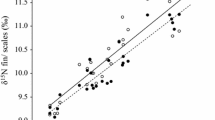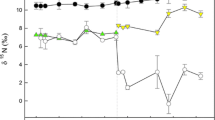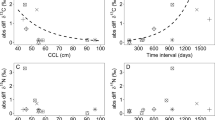Abstract
Stable isotopes are widely used as time-integrating tracers of trophic interactions, but turnover rates of isotopes in animal tissues remain poorly understood. Here, we report nitrogen (N) isotope turnover rates in tissues of four primary consumer species: Ancistrus triradiatus armored catfish (muscle, fins, and whole blood), Tarebia granifera snails (muscle), and Rana palmipes tadpoles (muscle) from a Venezuelan river, and Lavigeria grandis snails (muscle) from Lake Tanganyika, East Africa. Turnover was estimated from the dilution of a 15N label introduced into consumer tissues by feeding on 15N-enriched periphyton. Muscle turnover rates were rapid (0.5–3.8% per day), and were attributable to metabolic replacement of N as well as growth in catfish and snails. N turnover in catfish muscle decreased with size, and fin tissue turned over more rapidly than whole blood or muscle, though the difference was not significant. Our results indicate that stable isotope signatures of these tropical species could change markedly within weeks following a shift in diet. However, generalization across taxa or latitudes is complicated by the strong size-dependence of isotope turnover rates. The enrichment-dilution approach outlined here may facilitate measurement of isotopic turnover in a wide variety of consumers under field conditions.


Similar content being viewed by others
References
Ayliffe LK, Cerling TE, Robinson T, West AG, Sponheimer M, Passey BH, Hammer J, Roeder B, Dearing MD, Ehleringer JR (2004) Turnover of carbon isotopes in tail hair and breath CO2 of horses fed an isotopically varied diet. Oecologia 139:11–22
Baker RF, Blanchfield PF, Paterson MJ, Flett RJ, Wesson L (2004) Evaluation of nonlethal methods for the analysis of mercury in fish tissue. Trans Am Fish Soc 133:568–576
Bearhop S, Waldron S, Votier SC, Furness RW (2002) Factors that influence assimilation rates and fractionation of nitrogen and carbon isotopes in avian blood and feathers. Physiol Biochem Zool 75:451–458
Benke AC (1998) Production dynamics of riverine chironomids: extremely high biomass turnover rates of primary consumers. Ecology 79:899–910
Beviss-Challinor MH, Field JG (1982) Analysis of a benthic community food web using isotopically labeled potential food. Mar Ecol Prog Ser 9:223–230
Bosley KL, Witting DA, Chambers RC, Wainright SC (2002) Estimating turnover rates of carbon and nitrogen in recently metamorphosed winter flounder Pseudopleuronectes americanus with stable isotopes. Mar Ecol Prog Ser 236:233–240
Burnham KP, Anderson DR (2002) Model selection and inference: a practical information-theoretic approach, 2nd edn. Springer, Berlin Heidelberg New York
Cabana G, Rasmussen JB (1996) Comparison of aquatic food chains using nitrogen isotopes. Proc Natl Acad Sci USA 93:10844–10847
Carter CG, Bransden MP (2001) Relationships between protein-nitrogen flux and feeding in greenback flounder, Rhombosolea tapirina. Comp Biochem Physiol A 130:799–807
Clarke A, Johnston NM (1999) Scaling of metabolic rate with body mass and temperature in teleost fish. J Anim Ecol 68:893–905
Cohen JE, Pimm SL, Yodzis P, Saldana J (1993) Body sizes of animal predators and animal prey in food webs. J Anim Ecol 62:67–78
Frazer TK, Ross RM, Quetin LB, Montoya JP (1997) Turnover of carbon and nitrogen during growth of larval krill, Euphausia superba Dana: a stable isotope approach. J Exp Mar Biol Ecol 212:259–275
Fry B, Arnold C (1982) Rapid 13C/12C turnover during growth of brown shrimp (Penaeus aztecus). Oecologia 54:200–205
Gannes LZ, O’Brian DM, Martinez del Rio C (1997) Stable isotopes in animal ecology: assumptions, caveats, and a call for more laboratory experiments. Ecology 78:1271–1276
Gillooly JF, Brown JH, West GB, Savage VM, Charnov EL (2001) Effects of size and temperature on metabolic rate. Science 293:2248–2251
Hall RO, Tank JL, Dybdahl MF (2003) Exotic snails dominate nitrogen and carbon cycling in a highly productive stream. Front Ecol Environ 1:407–411
Harvey CJ, Hanson PC, Essington T, Brown P, Kitchell JF (2002) Using bioenergetics models to predict stable isotope ratios in fishes. Can J Fish Aquat Sci 59:115–124
Herzka SZ, Holt GJ (2000) Changes in isotopic composition of red drum (Sciaenops ocellatus) larvae in response to dietary shifts: potential applications to settlement studies. Can J Fish Aquat Sci 57:137–147
Herzka SZ, Holt SA, Holt GJ (2001) Documenting the settlement history of individual fish larvae using stable isotope ratios: model development and validation. J Exp Mar Biol Ecol 265:49–74
Hesslein RH, Hallard KA, Ramlal P (1993) Replacement of sulfur, carbon, and nitrogen in tissue of growing broad whitefish (Coregonus nasus) in response to change in diet traced by δ34S, δ13C, and δ15N. Can J Fish Aquat Sci 50:2071–2076
Hobson KA, Clark RG (1992) Assessing avian diets using stable isotopes I: turnover of δ13C in tissues. Condor 94:181–188
Kemp PF, Newell SY, Hopkinson CS (1990) Importance of grazing on the salt-marsh grass Spartina alterniflora to nitrogen turnover in a macrofaunal consumer, Littorina irrorata, and to decomposition of standing-dead Spartina. Mar Biol 104:311–319
MacAvoy SE, Macko SA, Garman GC (2001) Isotopic turnover in aquatic predators: quantifying the exploitation of migratory prey. Can J Fish Aquat Sci 58:923–932
Maruyama A, Yamada Y, Rusuwa B, Yuma M (2001) Change in stable nitrogen isotope ratio in the muscle tissue of a migratory goby, Rhinogobius sp., in a natural setting. Can J Fish Aquat Sci 58:2125–2128
McCutchan JH, Lewis WM Jr (2001) Seasonal variation in stable isotope ratios of stream algae. Verh Int Verein Limnol 27:3304–3307
McCutchan JH, Lewis WM Jr, Kendall C, McGrath CC (2003) Variation in trophic shift for stable isotope ratios of carbon, nitrogen, and sulfur. Oikos 102:378–390
McIntyre PB, Baldwin S, Flecker AS (2004) Effects of behavioral and morphological plasticity on risk of predation in a Neotropical tadpole. Oecologia 141:130–138
Merriam JL, McDowell WH, Tank JL, Wollheim WM, Crenshaw CL, Johnson SL (2002) Characterizing nitrogen dynamics, retention, and transport in a tropical rainforest stream using an in situ 15N addition. Freshw Biol 47:143–160
Mulholland PJ, Tank JL, Sanzone DM, Wollheim WM, Peterson BJ, Webster JR, Meyer JL (2000) Nitrogen cycling in a forest stream determined by a 15N tracer addition. Ecol Monogr 70:471–493
O’Reilly CM, Hecky RE, Cohen AS, Plisnier PD (2002) Interpreting stable isotopes in food webs: recognizing the role of time averaging at different trophic levels. Limnol Oceanogr 47:306–309
Pearson SF, Levey DJ, Greenberg CH, Martinez del Rio C (2003) Effects of elemental composition on the incorporation of dietary nitrogen and carbon signatures in an omnivorous songbird. Oecologia 135:516–523
Peters RH (1983) The ecological implications of body size. Cambridge University Press, Cambridge
Peterson BJ, Fry B (1987) Stable isotopes in ecosystem studies. Annu Rev Ecol Syst 18:293–320
Post DM (2002) Using stable isotopes to estimate trophic position: models, methods, and assumptions. Ecology 83:703–718
Schmidt O, Scrimgeouer CM, Curry JP (1999) Carbon and nitrogen stable isotope ratios in body tissue and mucus of feeding and fasting earthworms. Oecologia 118:9–15
Solomon C, Flecker AS, Taylor B (2004) Testing the role of sediment-mediated interactions between tadpoles and armored catfish in a Neotropical stream. Copeia 2004:610–616
Steffan S, Daane K, Mahr D (2001) 15N-enrichment of plant tissue to mark phytophagous insects, parasitoids, and flower-visiting entemophaga. Entomol Exp Appl 98:173–180
Sterner RW, Elser JJ (2002) Ecological stoichiometry: the biology of elements from molecules to the biosphere. Princeton, N.J.
Tieszen LL, Boutton T, Tesdahl K, Slade N (1983) Fractionation and turnover of stable carbon isotopes in animal tissues: implications for δ13C analysis of diet. Oecologia 57:32–37
Tominaga O, Uno N, Seikai T (2003) Influence of diet shift from formulated feed to live mysids on the carbon and nitrogen stable isotope ratio (δ13C and δ15N) in dorsal muscles of juvenile Japanese flounders, Paralichthys olivaceus. Aquaculture 218:265–276
Vanderklift MA, Ponsard S (2003) Sources of variation in consumer-diet δ15N enrichment: a meta-analysis. Oecologia 136:169–182
Vander Zanden MJ, Cabana G, Rasmussen JB (1997) Comparing trophic position of freshwater fish calculated using stable nitrogen isotope ratios (δ15N) and literature dietary data. Can J Fish Aquat Sci 54:1142–1158
Vander Zanden MJ, Hulshof M, Ridgway MS, Rasmussen JB (1998) Application of stable isotope techniques to trophic studies of age-0 smallmouth bass. Trans Am Fish Soc 127:729–739
Vander Zanden MJ, Rasmussen JB (1999) Primary consumer δ13C and δ15N and the trophic position of aquatic consumers. Ecology 80:1395–1404
Vander Zanden MJ, Rasmussen JB (2001) Variation in δ13C and δ15N trophic fractionation: implications for aquatic food web studies. Limnol Oceanogr 46:2061–2066
Webb SC, Hedges REM, Simpson SJ (1998) Diet quality influences the δ13C and δ15N of locusts and their biochemical components. J Exp Biol 201:2903–2911
Werner EE (1986) Amphibian metamorphosis: growth rate, predation risk, and the optimal size at transformation. Am Nat 128:319–341
West K, Michel E, Todd J, Brown D, Clabaugh J (2003) The gastropods of Lake Tanganyika: diagnostic key, classification, and notes on the fauna. Soc Int Limnol Spec Publ 2:1–132
Witting DA, Chambers RC, Bosley KL, Wainright SC (2005) Experimental evaluation of ontogenetic diet transitions in summer flounder (Paralichthys dentatus), using stable isotopes as diet tracers. Can J Fish Aquat Sci 61:2069–2084
Acknowledgments
Our study design was greatly improved by suggestions from Beth Boyer, Francis Chan, and Bob Howarth. We thank Martin Genner, Bob Hall, Ellinor Michel, Steve Thomas, two anonymous reviewers, and especially David Post for comments on the manuscript. Bryon Daley, Bob Hall, Corbin Hodges, George Kazumbe, Ellinor Michel, Michelle Olsgard, and Brad Taylor provided advice and assistance in the field. Chris Solomon and Ellinor Michel provided access to unpublished data, and Art Kasson analyzed the samples at the Cornell Isotope Laboratory. We thank Steve Ellner and Francoise Vermeylen for assistance with curve fitting and model selection, and Frank Wesselingh for identifying Tarebia. Logistical support in Venezuela was provided by the Perez family, Donald Taphorn, and the Figueredo family. The staff of the Tanzanian Fisheries Research Institute and Nyanza Project kindly provided logistical support at Lake Tanganyika, and the Tanzanian Committee for Science and Technology granted permission to conduct the research. This work was funded by the NSF through grants to PBM and ASF (INT-0321443 and DEB-0321471), the Nyanza Project (ATM-0223920), and the IGERT in Biogeochemistry and Environmental Biocomplexity at Cornell University.
Author information
Authors and Affiliations
Corresponding author
Additional information
Communicated by David Post
Rights and permissions
About this article
Cite this article
McIntyre, P.B., Flecker, A.S. Rapid turnover of tissue nitrogen of primary consumers in tropical freshwaters. Oecologia 148, 12–21 (2006). https://doi.org/10.1007/s00442-005-0354-3
Received:
Accepted:
Published:
Issue Date:
DOI: https://doi.org/10.1007/s00442-005-0354-3




